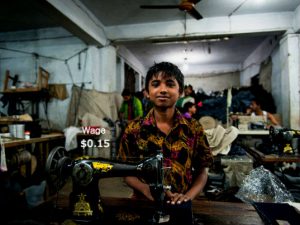The Ad

The Problem
H&M is a multinational Swedish clothing brand that is well known for its quick catwalk to store turnover and affordable prices. Their advertisements are typically very simple with an emphasis on the clothing and the low cost of the items. This particular advertisement shows two posed models in fashionable H&M dresses with the price of the dresses next to them. The purpose of this ad is to make the consumer desire the dress as well as show that the dress is so inexpensive that it easily accessible to the average consumer. What the advertisement disregards is how the clothing can possibly be fabricated so cheaply. H&M has been involved in numerous labour scandals ranging from low wages, to child labour, to unsafe working conditions. These accusations date back from 2011 when nearly 200 workers passed out due to toxic fumes, and have occurred as recently as February 2017 when the Guardian reported children working at H&M factories for as little as $0.15 USD an hour. Nonetheless, H&M has been able to take the spotlight off of these horrific conditions and continues to be the second largest global retailer.
Although the simplicity of the advertisement makes it seem relatively harmless, it is extremely representative of global consumerism. Simply put, people are drawn to low prices, regardless of quality, as it allows consumers to buy “more”. Since H&M has such affordable prices, people are able to buy in larger quantities and more frequently, fulfilling their needs as consumers and thus choosing to be blind to how things are actually fabricated. This advertisement needed some adjustments to show consumers the impact of their purchases have on the world.
The Jammed

The Philosophy
The jammed version of the advertisement mimics the theme of the original image. A young boy is shown amidst a clothing factory, with simple text reading “Wage $0.15”. The image is intended to invoke a sense of injustice, which is achieved through three avenues. Most obviously, the jammed image shows that H&M employs child labourers for the fabrication of their clothing. Child labour is widely accepted as exploitive as it deprives children of a childhood and is both mentally and physically dangerous. H&M has continuously been reported to hire children and force them to work long hours, with the latest report as recent as February 2017. The second issue that this image evokes is a concern about factory conditions. The background shows a filthy and unpleasant working environment which is likely lacking important safety features. Although this image may not be taken at an H&M factory, H&M has had countless reports of unsafe working conditions. Moreover, even after the company signed an international safety accord in 2011, H&M has still failed to upgrade the conditions of their buildings to eliminate safety hazards. Lastly, the most obvious critique this jammed advertisement has on the company’s practices is the wage of the factory workers. 15 cents is an actual accusation of hourly wages reported at an H&M in Myanmar in early 2017. A fair wage is a wage that allows workers to pay for basic needs, and regardless of country of origin, 15 cents is insufficient.
Although both the original and jammed advertisements are quite simple, they both speak a great deal about H&M’s brand and values (or lack thereof). Child labour, unsafe working environments, and unfair wages are widely accepted as exploitative practices, however they have not hindered H&M’s ability to be a retail power player. The jammed image is meant to bring some reality to the original advertisement and force people to question whether the affordability of the clothing is worth the impact it has on the global community.